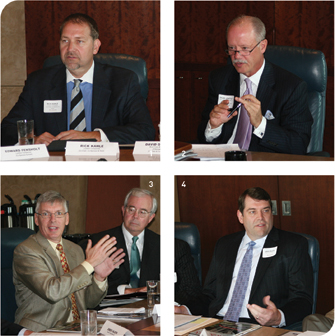
1. Rick Kahle said his hope was that health-care reform would make the process less expensive and less cumbersome, but “They’ve done just the opposite.” | 2. David Gentile said game-changing processess had been put in place, but not clarity in the rules to play by. | 3. Ed Fensholt offered a sobering assessment of health-care reform’s likely impact on many small businesses. | 4. Greg Klein staked out one of the strongest positions against implementation of federal reforms, based both on cost considerations and freedom of choice for individuals.
For the first several respondents around the table hope reigned. Carolyn Watley, president of CBIZ Benefits and Insurance Services, threw in the first caution. “I have a fear of cost and complexity,” she noted. That much said, she hoped that “the entire health of our entire population as a nation improves as a result of all this.”
As the conversation moved around the table, skepticism seemed to mount.
“It was a bad bill, a bad piece of legislation,” said the plain-spoken Mark Avery, CEO of Power Group. Still, he too hoped that “good will come of it.”
By the time the discussion reached Greg Klein, CFO of Inland Truck Parts, the assembly heard a different kind of hope altogether. “My greatest hope,” said Klein, “is that the law gets repealed or struck down as unconstitutional.”
Mincing no words, Klein went on to suggest that the impending reform represented “a huge leap away from freedom of choice and a leap toward mandates.” He feared that in his employee-owned company, which covers some 85 percent of its workers, the mandate to cover the other 15 percent would cause a rationing of care among those already covered.
“The clarity is just not there,” said Gentile, summing up the responses to the opening question. “We’re going to have game changers without rules to play by.”
As the rest of the conversation progressed, an observer got the sense that the participants were all prepared to make the best of it, and maybe even eke out some modest improvements, but no one expressed enthusiasm for the legislation, and some expressed something very much like hostility.
Said Rick Kahle of the government’s involvement in health-care delivery, “I would hope they would somehow make this less expensive, less cumbersome, and they’ve done just the opposite.”
Modeling the Future
Working from a sample of about 135 current customers, the Lockton staff modeled likely down-the-road costs. As Ed Fensholt, leader of the Lockton Health Reform Advisory Practice, discovered, the results were a bit unsettling. Lockton broke out its clients into two large groups: retail, restaurant, entertainment, hospitality in one group; and everybody else in the second.
What Lockton found is that the “everybody else” clients would save roughly 41 to 44 percent of their current health care costs by simply terminating group coverage and sending their employees into the new federally subsidized insurance exchanges. The employees, however, would fare worse in these exchanges, and this might provide a competitive incentive for the employers to stay in the game.
The first group of clients, said Fensholt, the retailers and the like, “simply get destroyed under this construct.” They typically cannot afford to extend robust coverage to their rank-and-file employees. Nor can they afford the $2,000-per-employee penalty per year to offer no coverage. The only real option for these businesses, said Fensholt, “is to move a whole lot of folks from full-time employees into part-time.”
Fensholt sees little chance that this legislation will be repealed. There is some likelihood, however, that the Supreme Court will find it unconstitutional. That will likely not be known until late next year. Savvy Democrats or Republicans, Fensholt believes, will “really want the Supreme Court to step in and throw this thing out.”
Greg Klein argued, as Fensholt did, that the penalty for opting out will not remain $2,000 per year for long. His company spends $10,000 a year now per employee. If his and other companies try to save $8,000 per year per employee, these decisions will quickly force the government to up the penalty.